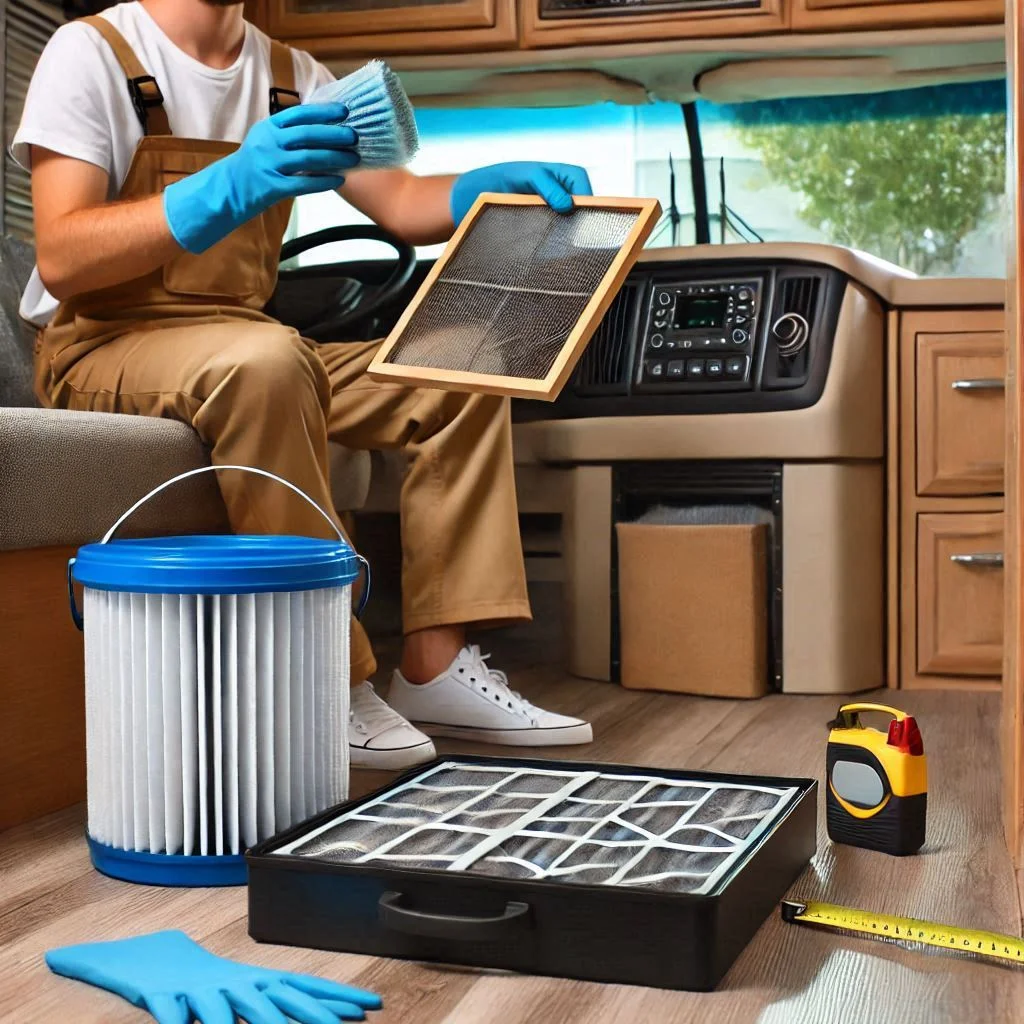How to Turn on the Air Conditioner in Your RV
Introduction
Turning on your RV air conditioner is essential for staying comfortable during hot weather. If you’re new to RV life or just need a quick refresher, this guide will walk you through the steps to turn on the AC and troubleshoot common issues. Follow these simple instructions to enjoy a cool, comfortable ride.
Step-by-Step Guide to Turning on the AC Unit in Your RV
- Check the Power Source
Before you do anything, ensure your RV is connected to a power source. Most RV air conditioners require a 30-amp or 50-amp hookup, depending on your RV model. If you’re running off battery power, make sure the batteries are sufficiently charged to avoid power interruptions. - Locate the Thermostat
Most RV air conditioners are controlled by a wall-mounted thermostat. This is usually found in the living area or near the entry door. Make sure the thermostat is set to cooling mode (often denoted by a snowflake icon). - Set the Desired Temperature
Once the thermostat is in cooling mode, adjust the temperature to your preference. Keep in mind that RV air conditioners can be more efficient when the temperature is set between 72°F and 75°F. Setting it too low can cause the unit to overwork, while a higher setting might not provide sufficient cooling. - Turn on the AC Unit
Now that your thermostat is set, turn on the air conditioner by pressing the “On” button on the thermostat or remote control. Wait for a few minutes, and you should feel cool air blowing from the vents. - Check Vents for Proper Airflow
Ensure the AC vents are unobstructed. Clear any debris or objects that could block airflow and reduce cooling efficiency.
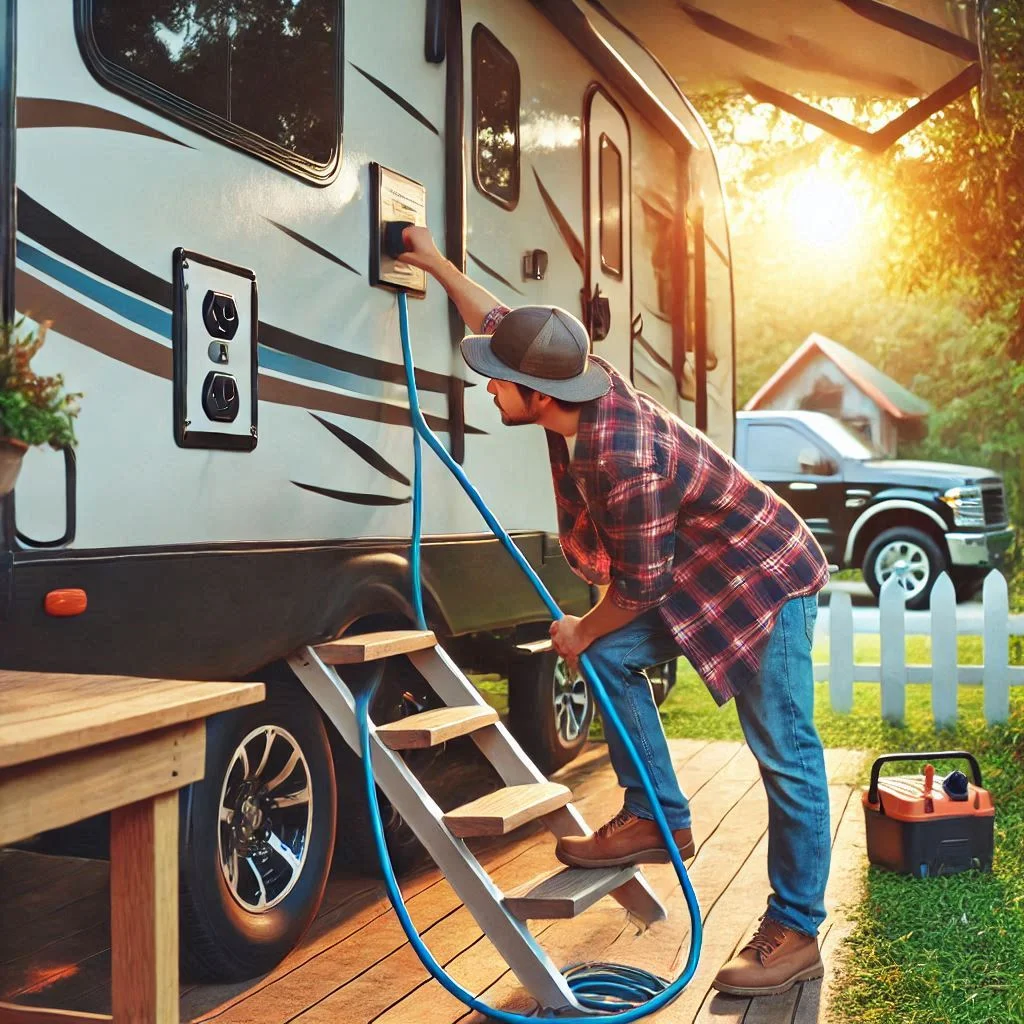
Common Troubleshooting Tips for Turning on Your RV Air Conditioner
If your RV air conditioner is not turning on or is not cooling properly, here are some troubleshooting steps you can follow:
- Verify the Power Supply
Ensure your RV is plugged into a power source that provides adequate voltage. If you’re running on 30-amp power and the unit is not turning on, it might not have enough power. Consider using a 50-amp supply for higher efficiency. - Check the Breaker
If the RV AC unit isn’t starting, check your RV’s electrical panel for a tripped breaker. Reset it if necessary, and try turning the air conditioner on again. - Clean the Air Filters
Dirty air filters can hinder airflow and cause the AC to underperform. Remove the filters from the AC unit, clean them with water or replace them if necessary. - Inspect the Thermostat
If your thermostat is malfunctioning, it could prevent the AC from turning on. Try adjusting the settings and see if it responds. If not, you may need to replace or repair the thermostat. - Check the Condenser Coils
Dirty or blocked condenser coils can also cause cooling issues. Ensure the area around the air conditioner is clean and free of debris, and if needed, hire a professional to inspect and clean the coils. - Ensure the RV’s Generator is Functioning Properly
If you’re relying on an RV generator to power your AC unit, make sure it’s working properly. A malfunctioning generator could prevent the AC from receiving enough power to turn on.
How Does an RV Air Conditioner Work?
Introduction
Understanding how your RV air conditioner works is crucial for maintaining optimal cooling performance during your travels. RV air conditioners use a refrigeration process similar to home air conditioning units but are specifically designed to handle the unique needs of mobile living. In this guide, we’ll break down the mechanics behind RV air conditioners and explain the cooling process to help you keep your RV cool and comfortable all year round.
Explanation of the Mechanics Behind RV Air Conditioners
RV air conditioners operate based on the same principle as residential air conditioners: they move heat from inside the RV to the outside environment. The cooling process is accomplished through the refrigeration cycle, which involves the following components:
- Evaporator Coil
The evaporator coil is the part of the RV air conditioner that absorbs heat from the air inside the RV. When warm air is drawn into the AC unit, it passes over the evaporator coil, where the refrigerant inside the coil absorbs the heat, cooling the air. - Compressor
The compressor is responsible for pressurizing the refrigerant and pushing it through the system. This is where the air conditioner’s refrigeration cycle starts. The compressor draws in low-pressure refrigerant gas, compresses it into a high-pressure gas, and sends it to the condenser coil. - Condenser Coil
Once the refrigerant reaches the condenser coil, it begins to release the heat it absorbed from inside the RV. As the refrigerant cools down, it turns into a high-pressure liquid and moves on to the next stage in the cycle. The condenser coil is located outside the RV to help release the heat into the surrounding air. - Expansion Valve
The expansion valve regulates the flow of refrigerant into the evaporator coil. As the high-pressure liquid refrigerant enters the expansion valve, it rapidly drops in pressure and becomes a cold mist. This mist is what absorbs heat from inside the RV, completing the cycle. - Blower Fan
The blower fan is responsible for circulating the cooled air throughout the RV. Once the heat has been absorbed by the evaporator coil and transferred to the condenser coil, the blower fan pushes the cool air into the RV, providing relief from the heat.
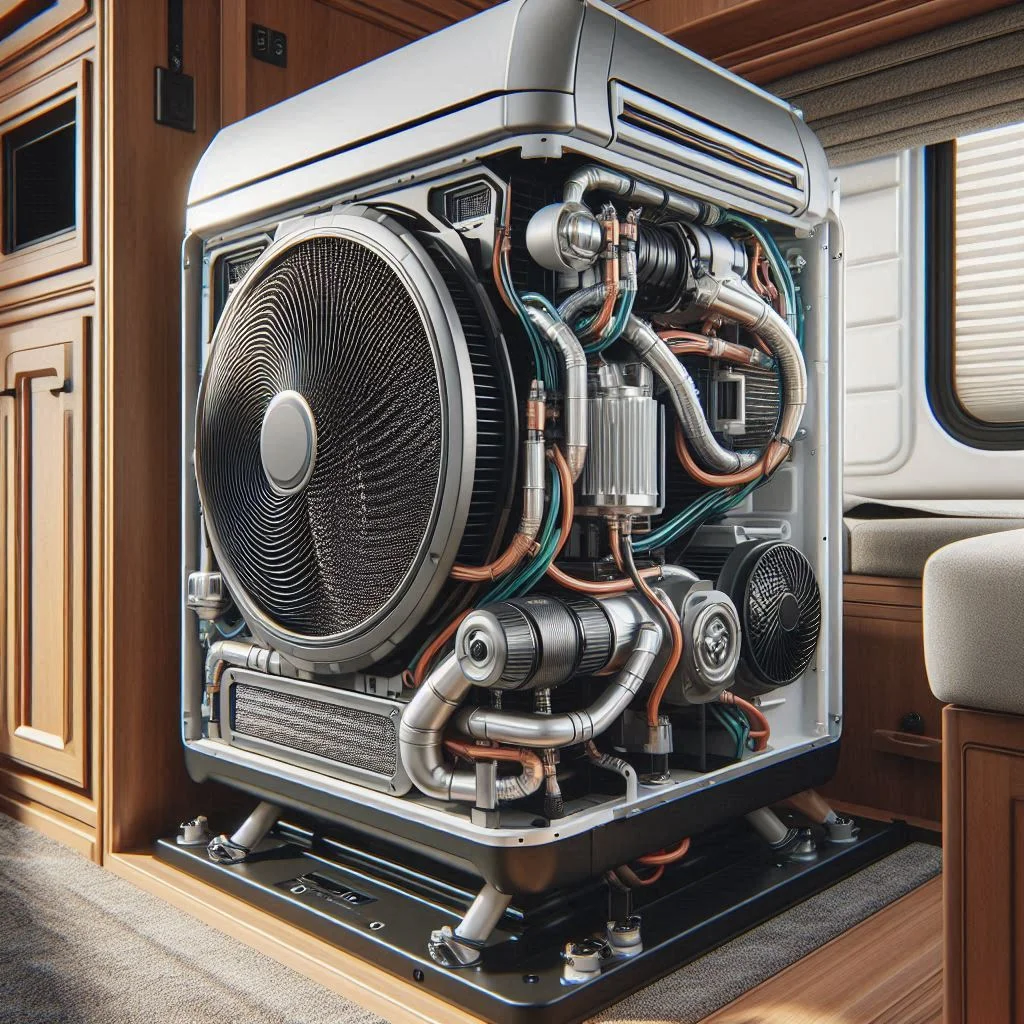
Understanding the Cooling Process in Your RV AC
The cooling process in your RV air conditioner begins with the compressor. Here’s how it works in detail:
- Air Intake
When you turn on the air conditioner, warm air from inside the RV is drawn into the unit through intake vents. This air is filtered before being directed over the evaporator coil. - Heat Absorption
As the warm air flows over the evaporator coil, the refrigerant inside the coil absorbs the heat from the air. The heat causes the refrigerant to evaporate, turning it into a low-pressure gas. - Compression and Heat Transfer
The refrigerant gas is then compressed by the compressor, causing it to become a high-pressure gas. This gas is sent to the condenser coil, where the heat it absorbed inside the RV is released to the outside air. - Cooling the Air
As the refrigerant cools and condenses back into a liquid, it moves back toward the expansion valve. The expansion valve allows the liquid refrigerant to expand rapidly, turning it into a cold mist that is directed toward the evaporator coil. - Circulation of Cool Air
The cool air is then blown through the ducts and vents inside the RV by the blower fan, providing you with a cool, comfortable atmosphere.
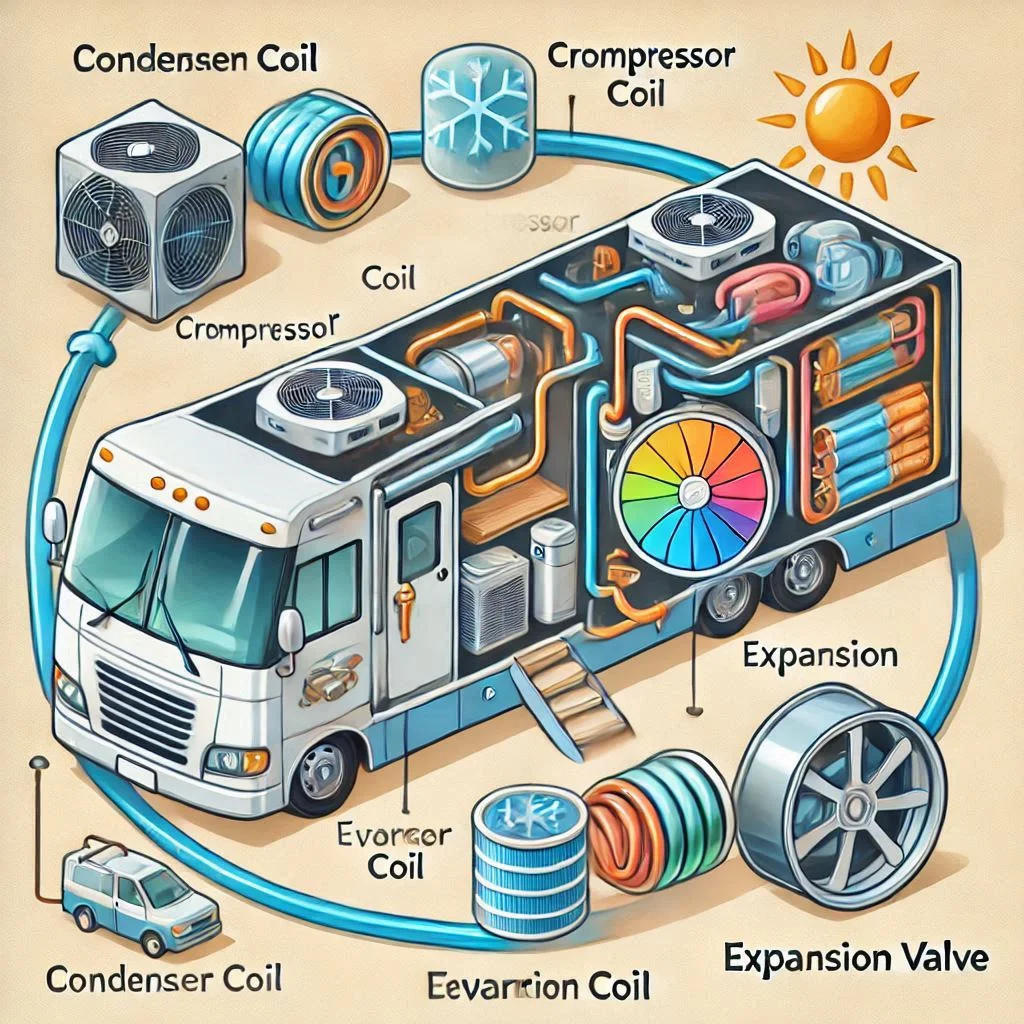
Why Understanding This Process is Important
Knowing how your RV air conditioner works will help you identify and fix any issues that arise. Regular maintenance is necessary to ensure each part of the cooling cycle functions optimally. Whether you’re troubleshooting a lack of cool air or just want to know how to maintain your unit, understanding the mechanics of the RV AC unit can save you time and money.
Common RV Air Conditioner Issues Related to Cooling
- Low Refrigerant Levels
If the refrigerant levels in the system are too low, the air conditioner will struggle to cool effectively. This often happens due to leaks or poor maintenance. - Clogged Filters
A clogged air filter can restrict airflow, reducing the efficiency of the cooling process. Make sure to clean or replace your air filters regularly to ensure maximum cooling performance. - Dirty Coils
Dirt and debris can accumulate on the evaporator and condenser coils, impeding the refrigerant’s ability to absorb and release heat. Cleaning the coils annually is essential for optimal function. - Malfunctioning Compressor
If the compressor is malfunctioning, the entire cooling process will fail. A faulty compressor is a common issue that requires professional repair or replacement.
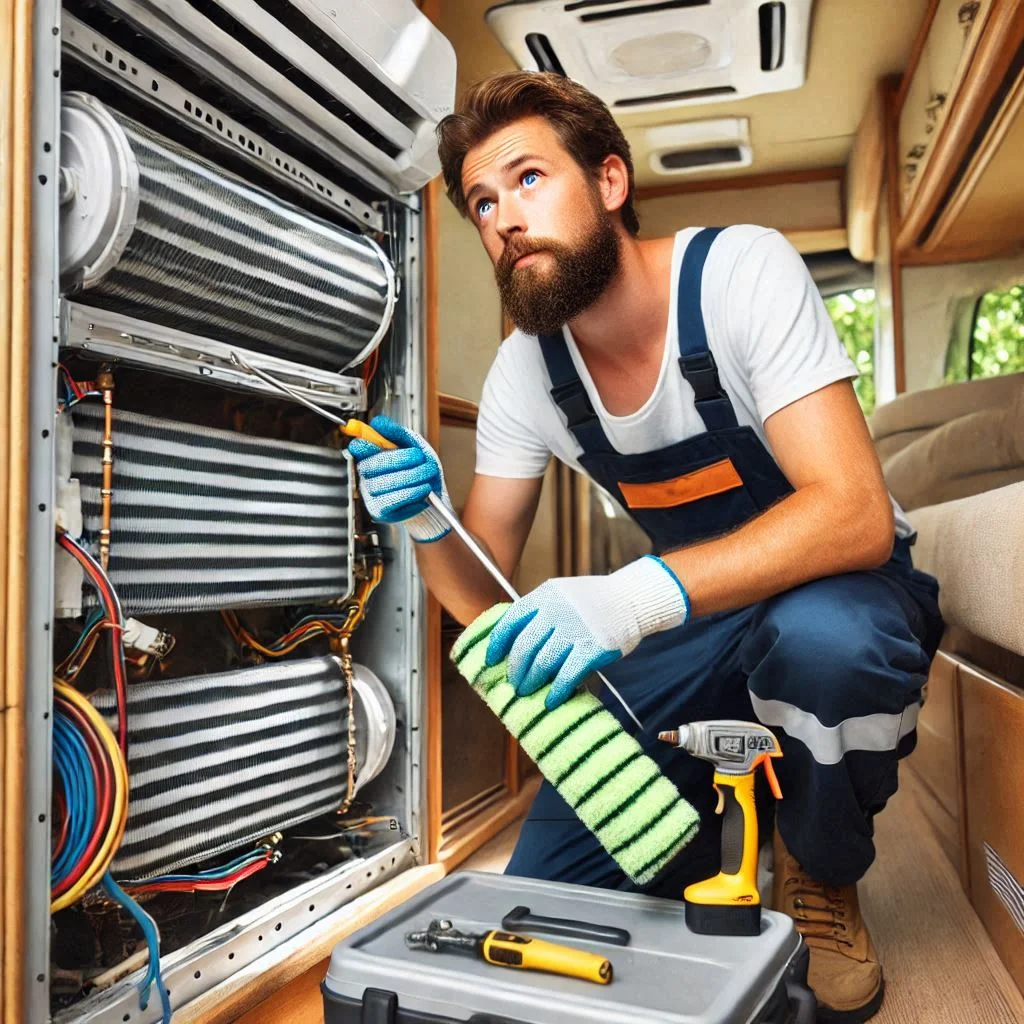
Can an RV Air Conditioner Run Continuously?
Introduction
During hot weather or on extended RV trips, it’s tempting to leave the air conditioner running non-stop to keep your RV cool. However, running your RV air conditioner continuously has both benefits and drawbacks. In this guide, we’ll explore the pros and cons of leaving your RV air conditioner on all the time, and how long it’s safe to do so.
Pros and Cons of Running Your RV Air Conditioner Non-Stop
Pros of Running Your RV AC Continuously
- Consistent Comfort
Leaving the AC on continuously ensures that the temperature inside your RV remains stable and comfortable. This is especially important if you’re in areas with consistently high temperatures, where turning the AC on and off could lead to discomfort or excessive humidity. - Prevents Overheating
In extremely hot environments, running your AC non-stop prevents your RV’s interior from getting too hot. High temperatures can damage electronics, furniture, and even the RV’s structure. Continuous cooling ensures these components stay in good condition. - Improved Air Quality
Running your AC continuously helps circulate fresh air inside the RV. Many RV air conditioners have built-in filtration systems that remove dust, pollen, and other allergens, which is especially beneficial for those with respiratory conditions. - Efficient Dehumidification
One of the benefits of RV air conditioners is their ability to reduce humidity levels inside the vehicle. Running the AC continuously helps keep the air dry and comfortable, reducing the risk of mold growth or mildew accumulation.
Cons of Running Your RV AC Continuously
- Higher Energy Consumption
One of the biggest downsides to running your RV air conditioner continuously is the increase in energy consumption. Constantly running the AC puts a significant load on your RV’s power system, potentially draining batteries or using up fuel in case of generator-powered AC units. - Wear and Tear
Non-stop operation can lead to faster wear and tear on the air conditioning unit. Over time, components like the compressor and blower fan can become worn out, requiring expensive repairs or replacement. Frequent use without proper maintenance can shorten the lifespan of the unit. - Noise
If you’re parked in a quiet area or trying to sleep, the noise from the AC unit may be bothersome. Running the air conditioner non-stop could disrupt your peace and quiet, especially in campgrounds or rural areas where noise levels are usually low. - Potential Freezing of the Unit
In rare cases, running the AC unit for extended periods without giving it time to cycle off can cause the evaporator coil to freeze. This can lead to a blockage in the airflow, reducing the effectiveness of your air conditioner and possibly causing damage.
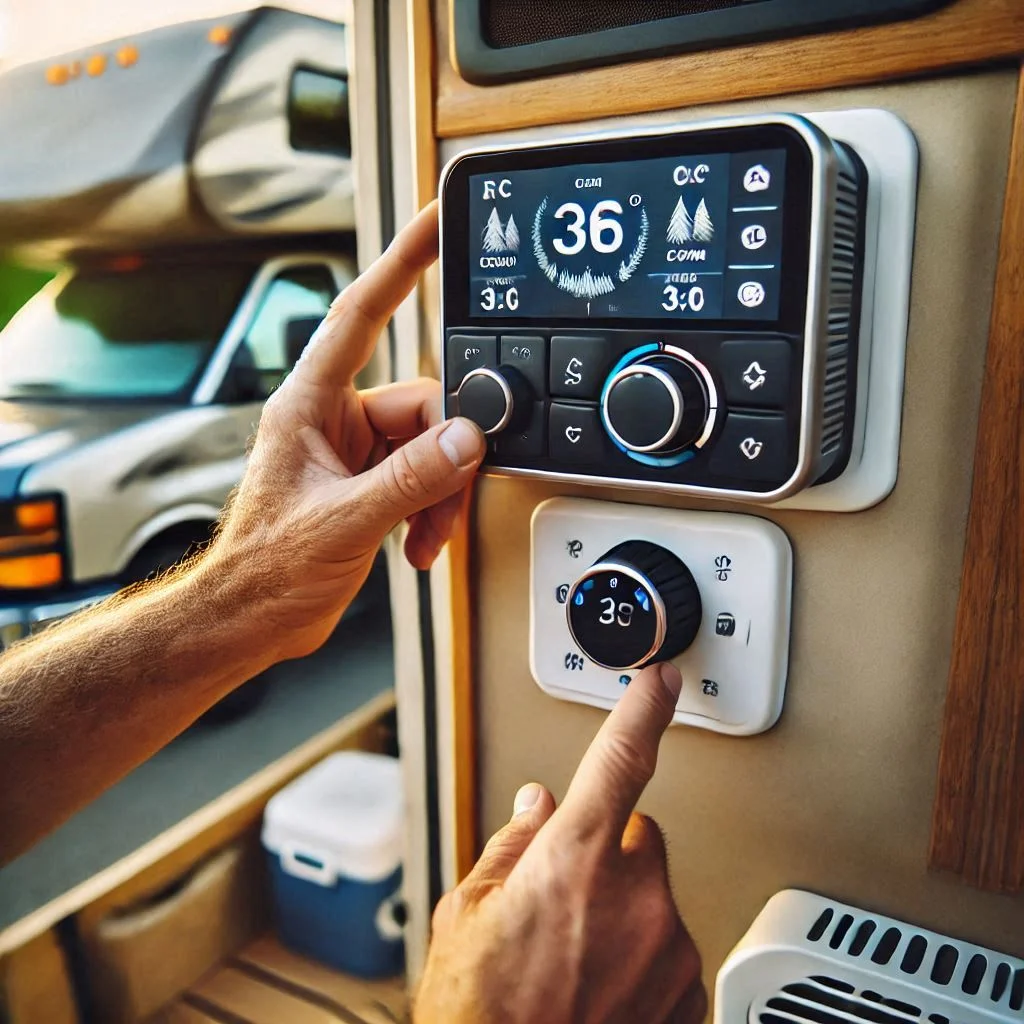
How Long Is It Safe to Leave Your RV AC Running?
Short-Term Continuous Use
In most cases, running your RV air conditioner continuously for a short period (such as a few hours) is safe, especially in hot weather. As long as your power source is sufficient (whether battery or generator), it won’t cause significant damage. Ensure the air filters are clean and the unit is properly maintained to prevent overheating.
Long-Term Continuous Use
For longer durations, it’s best to avoid keeping the RV AC running continuously. Most experts recommend giving the air conditioner some downtime to avoid excessive wear and tear on its components. If you need to leave the AC running for extended periods, consider doing so only when connected to a reliable power source, such as shore power or a well-maintained generator.
Recommended Practices for Running Your RV AC Safely
- Use a Timer or Smart Thermostat
Using a timer or smart thermostat allows you to control the air conditioner’s operation. These devices can help you set periods for the AC to cycle on and off, preventing it from running non-stop while still maintaining comfort. - Monitor the Power Source
Ensure that your power source can handle the demand of continuous AC operation. Running the AC on a 30-amp power source may not be sufficient for prolonged use, while a 50-amp source will provide better support. - Regular Maintenance
Regular maintenance is essential for ensuring the longevity and efficiency of your RV air conditioner. Clean the filters, check for blockages, and ensure the refrigerant levels are adequate to maintain optimal performance.
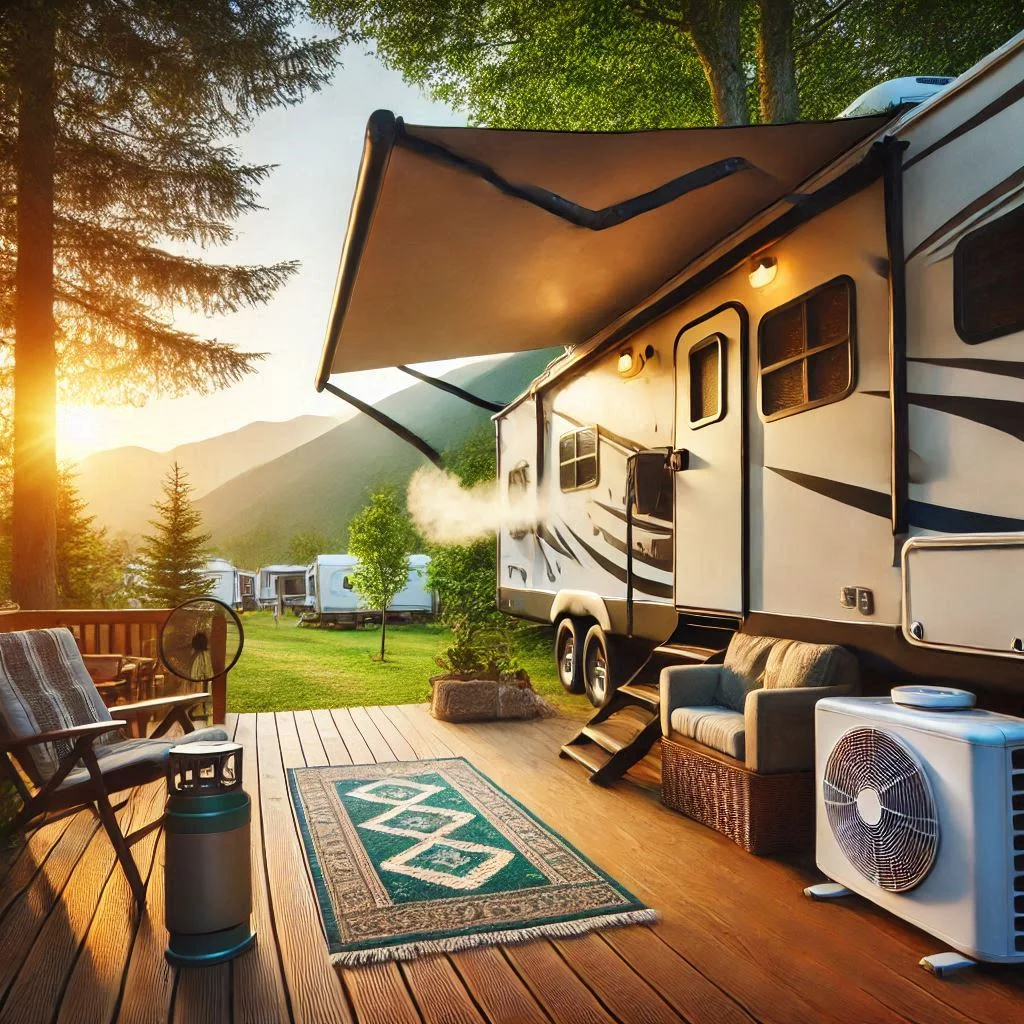
When Should You Turn Off Your RV Air Conditioner?
While leaving your AC running continuously may seem convenient, there are times when it’s best to switch it off:
- When You Don’t Need Cooling
If the outside temperature drops and the interior of your RV becomes cool, there’s no need to keep the air conditioner running. Switching it off will save power and extend the life of the unit. - When Leaving the RV
If you’re leaving your RV unattended for an extended period, it’s wise to turn off the air conditioner to prevent unnecessary energy consumption. - When Using Alternative Cooling Methods
During cooler nights, open the windows for natural ventilation or use portable fans. These options provide cooling without the need for running the air conditioner all the time.
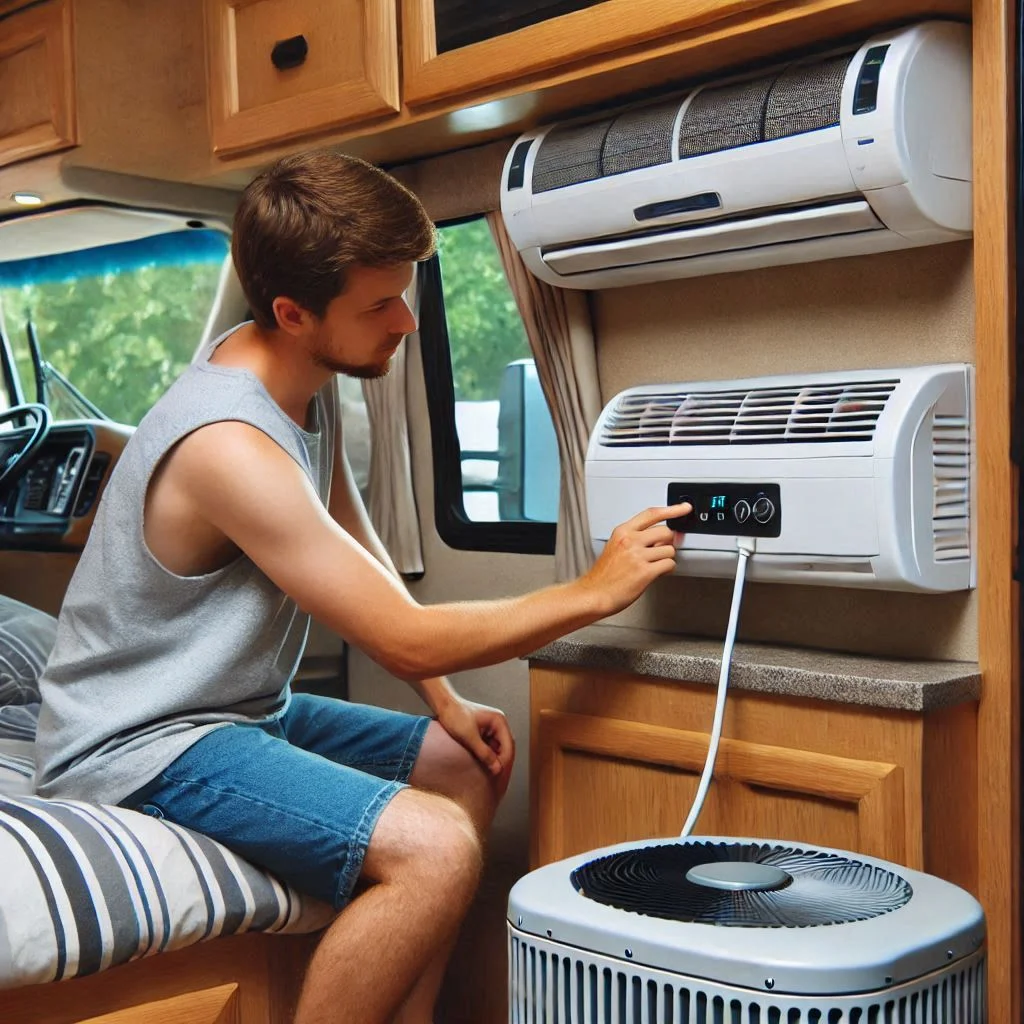
Can You Run an RV Air Conditioner on 30-amp or 15-amp Power?
Introduction
Running an RV air conditioner requires a reliable power source, but not all RVs are equipped with the same electrical systems. Some RVs come with a 30-amp power system, while others are equipped with a 15-amp system. Understanding the power requirements for your RV air conditioner is crucial for ensuring it operates efficiently without overloading your system. In this article, we’ll break down the differences between 30-amp and 15-amp circuits and help you determine if you can run your RV air conditioner on these power sources.
Power Requirements for Running an RV Air Conditioner
An RV air conditioner typically requires between 1,000 to 1,500 watts of power to run, with larger units requiring even more. The power needed will depend on the size and efficiency of the air conditioner, as well as environmental factors like the outside temperature.
- 1,000 to 1,500 Watts: This is the standard power consumption for most RV air conditioners. To put this into perspective, a typical RV air conditioner running on a 30-amp circuit consumes around 12-15 amps when operating. When starting up, the air conditioner can temporarily draw more power due to the surge required to activate the compressor.
- Inrush Current: The surge of power required when the AC unit starts up can be up to 3 times the normal running power. This is an important consideration when determining whether your RV’s power system can handle continuous operation of the air conditioner.
Key Differences Between 30-amp and 15-amp Circuits
Understanding the key differences between 30-amp and 15-amp circuits is essential for knowing whether your RV’s power system can support the air conditioner.
- 30-amp Circuit
- Power Supply: A 30-amp circuit provides 3,600 watts of power (120V x 30 amps). This is enough to power your RV’s air conditioner along with other essential appliances such as lights, a microwave, and a refrigerator.
- Capacity: With a 30-amp service, you’ll have enough power to run multiple appliances at once without overloading the system. Most RV air conditioners can operate safely on a 30-amp circuit, especially in moderate climates.
- Compatibility: A 30-amp power supply is the standard for most RVs, and it is ideal for powering an RV air conditioner continuously without any risk of overloading.
- 15-amp Circuit
- Power Supply: A 15-amp circuit provides 1,800 watts of power (120V x 15 amps). This is much less than a 30-amp circuit and may not be sufficient to power an air conditioner along with other appliances.
- Limitations: Running an air conditioner on a 15-amp circuit can cause the system to trip a breaker or overload. Additionally, the inrush current at startup may cause the power supply to fail, preventing the air conditioner from operating at full capacity.
- Compatibility: In most cases, a 15-amp circuit is not recommended for running an RV air conditioner. If you’re using a 15-amp power supply, it’s better to use smaller appliances or rely on an external power source like a generator or 30-amp shore power.
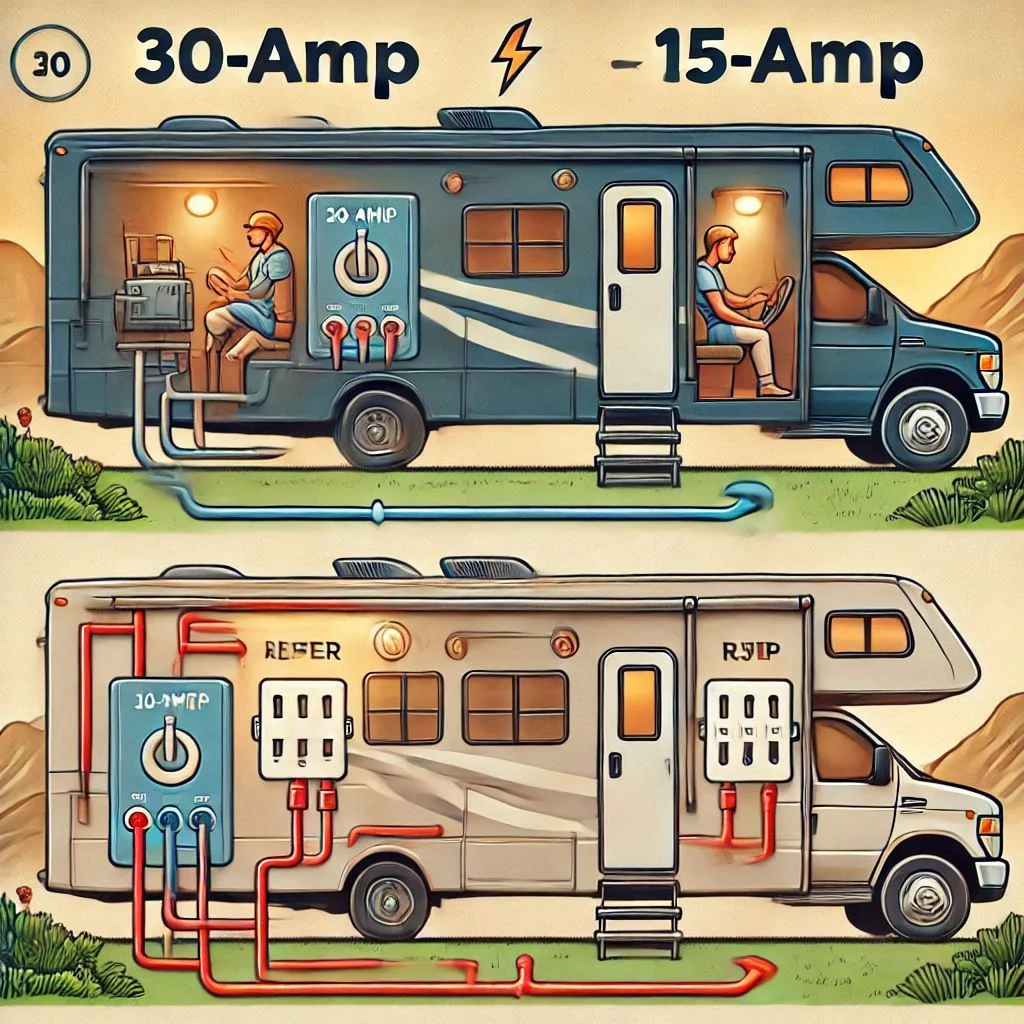
Can You Run an RV Air Conditioner on 30-amp Power?
Yes, most RV air conditioners are designed to run on a 30-amp power circuit. The 30-amp circuit provides enough power to support your air conditioner as well as other electrical needs in your RV. However, it’s essential to ensure your RV air conditioner does not exceed the available power. Most RVs with a 30-amp circuit are equipped to handle a typical air conditioner’s power draw, but always check the specific requirements of your AC unit to avoid overloads.
Considerations:
- Surge Power: Keep in mind that when the air conditioner starts, it draws a surge of power. This initial surge can be up to three times the normal running watts of the unit. For most 30-amp circuits, this surge is not an issue, but if your RV is running several high-wattage appliances simultaneously, it could cause a breaker to trip.
- Using Multiple Appliances: If you plan to use other high-power appliances like a microwave or hair dryer while the AC is running, you may need to manage your power consumption carefully to avoid overloading the system.
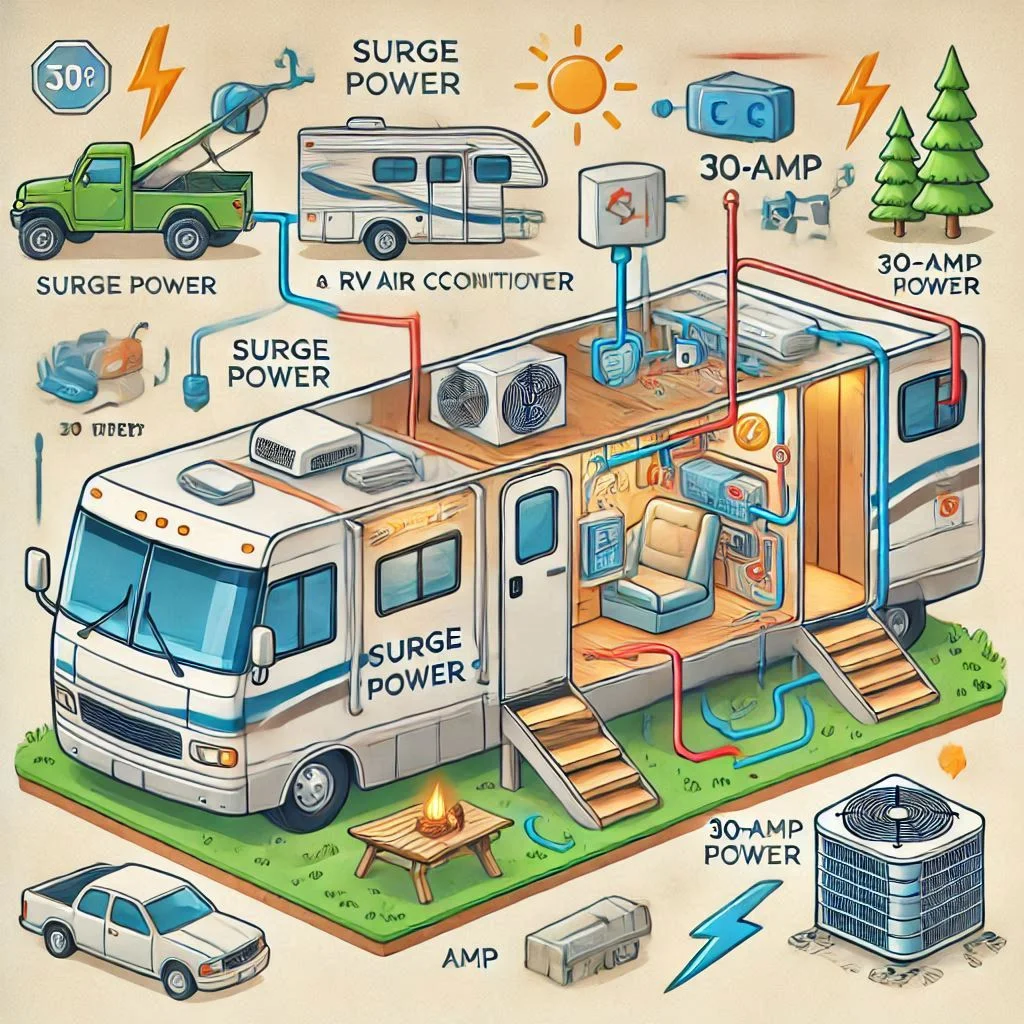
Can You Run an RV Air Conditioner on 15-amp Power?
Running an RV air conditioner on a 15-amp circuit is not ideal and could lead to issues. A 15-amp circuit simply doesn’t provide enough power to support the AC unit, especially when you factor in the surge of power during startup.
Issues with 15-amp Power Circuits:
- Overloading: With a 15-amp circuit, running an air conditioner will likely cause the circuit to overload, trip the breaker, or prevent the AC unit from starting altogether.
- Limited Appliances: If you must use a 15-amp circuit, you should avoid using other power-hungry devices like a microwave, toaster, or electric stove at the same time as your AC. The limited capacity of a 15-amp circuit simply can’t handle multiple appliances running simultaneously.
Solution:
- Use a Generator: If you are in a situation where only 15-amp power is available, consider using a portable generator that provides more power. A generator will give you the extra watts needed to run your air conditioner and other appliances.
- Upgrade to 30-amp or 50-amp: If your RV is frequently using a 15-amp circuit, it’s a good idea to upgrade to a 30-amp or 50-amp service for optimal performance and to avoid overloading your power system.
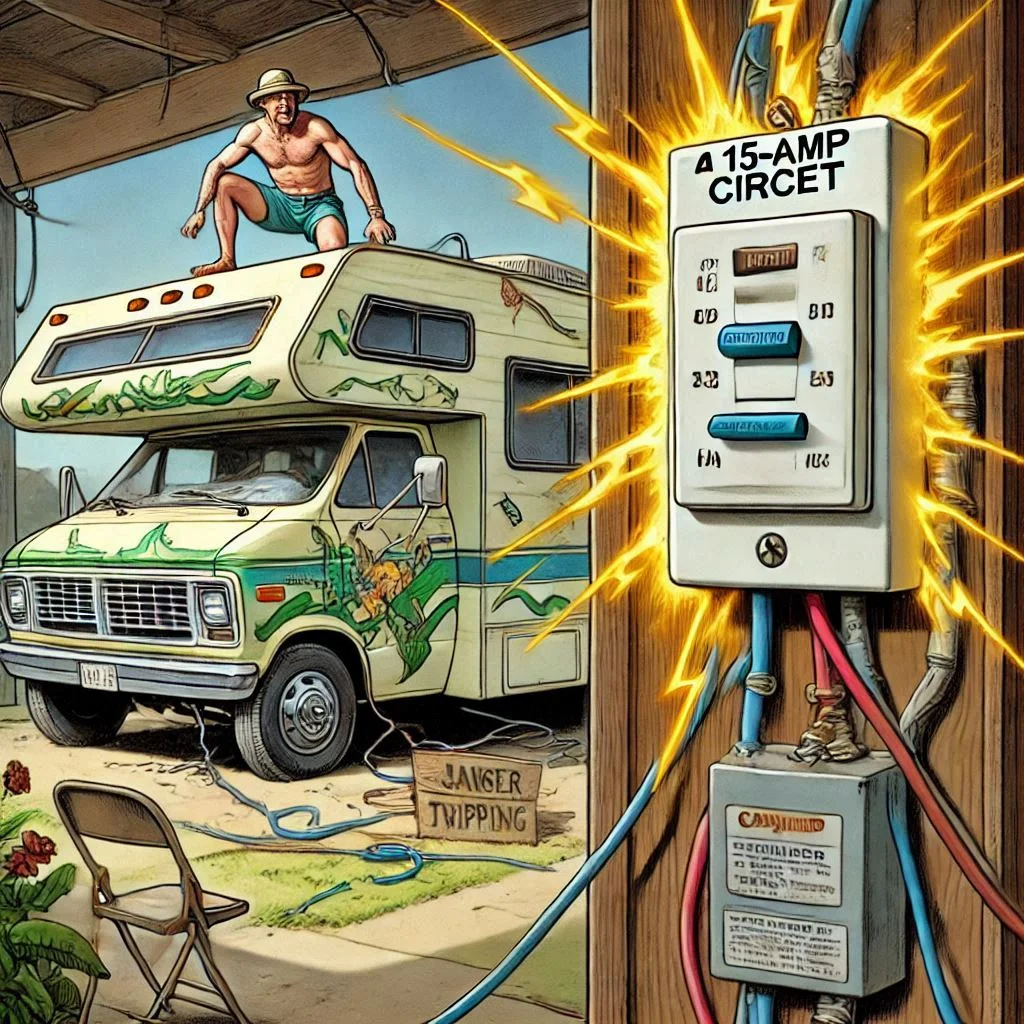
Best Practices for Safe and Efficient RV Air Conditioner Use
Introduction
Maintaining your RV air conditioner is key to ensuring it runs smoothly and lasts for years. Proper care, regular maintenance, and energy-efficient usage are essential for getting the most out of your unit while keeping your RV cool during your travels. In this article, we’ll cover essential tips for maintaining your RV air conditioner, as well as practical energy-saving tips for optimizing its performance.
Tips for Maintaining an Efficient and Long-lasting RV AC
Proper maintenance not only extends the lifespan of your RV air conditioner but also helps it run efficiently, saving you money on repairs and energy costs. Here are the top tips to keep your RV AC in top condition:
- Regular Cleaning of the Filters
Air filters play a crucial role in the efficiency of your RV air conditioner. Dirty filters restrict airflow, forcing the system to work harder and consume more energy. Clean the filters at least once a month or more frequently if you’re traveling in dusty environments.How to Clean Filters:- Turn off the air conditioner and remove the cover.
- Pull out the filters and wash them with warm water and mild soap.
- Let the filters dry completely before reattaching them.
This image will provide visual guidance on how to clean the filters.
- Check and Clean the Condenser Coils
Over time, dirt and debris can build up on the condenser coils, reducing the air conditioner’s efficiency. Clean the coils regularly to ensure the AC runs smoothly. You can use a coil cleaner or compressed air to blow off the debris. If the coils are heavily dirty, it may be necessary to have them professionally cleaned. - Inspect the Ductwork for Leaks
Leaky ducts waste cool air and make your RV air conditioner work harder. Inspect the ductwork for any visible signs of damage or leaks. If you find any, repair them promptly using duct tape or mastic sealant. - Ensure Proper Airflow Around the Unit
Always ensure that the area around the air conditioner is free of debris and obstructions. For rooftop units, make sure there is no buildup of leaves, twigs, or dirt around the vents. For inside units, check that vents are unobstructed by furniture or other items. - Schedule Professional Maintenance
Just like any other appliance, your RV air conditioner will benefit from regular professional maintenance. Schedule an annual inspection with a certified technician to ensure the system is running efficiently and to prevent major breakdowns.
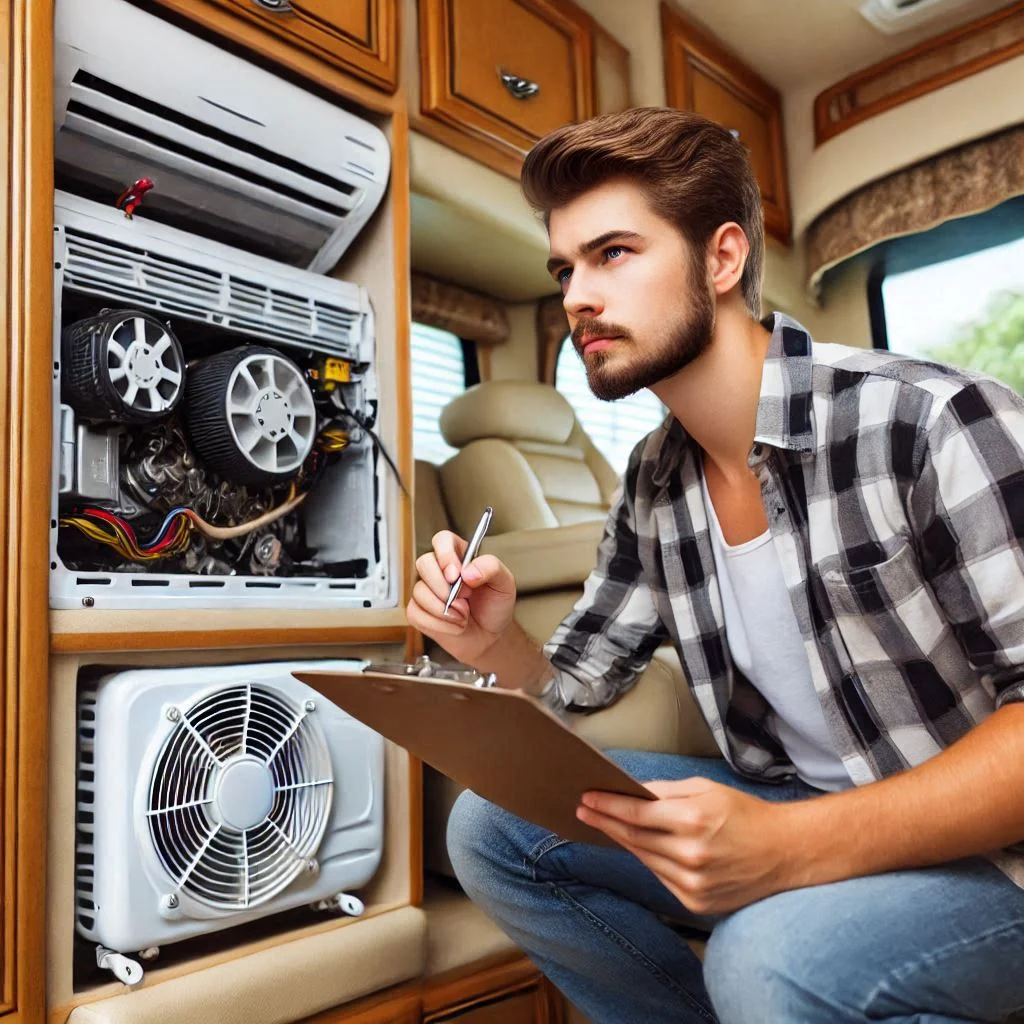
Energy-saving Tips When Using the Air Conditioner in Your RV
Energy efficiency is crucial when traveling in your RV. Using your air conditioner wisely not only helps reduce your electricity consumption but also saves money on energy costs. Here are some energy-saving tips to maximize efficiency:
- Use the Thermostat Wisely
Set your thermostat to a reasonable temperature, usually around 72°F (22°C). Avoid setting it to the lowest possible setting, as it will force the air conditioner to work harder. Use a programmable thermostat to maintain a consistent temperature without excessive cooling. - Park in the Shade
Whenever possible, park your RV in shaded areas to reduce the heat load on the air conditioner. The sun can heat up your RV’s interior quickly, making the AC work harder to cool it down. Shade from trees, other vehicles, or structures can significantly reduce the cooling load on your unit. - Use Ventilation Fans
If your RV is equipped with roof vents or fans, use them in conjunction with your air conditioner to improve airflow and help cool down the RV faster. Opening windows and allowing cross-ventilation can also help reduce the workload on the air conditioner, especially in the cooler parts of the day. - Seal Windows and Doors
Ensure that your RV windows and doors are properly sealed to prevent cool air from escaping and warm air from entering. Use weatherstripping or caulking to seal any gaps around windows and doors. The tighter the seal, the less your air conditioner will have to work. - Use Solar Power or a Generator
If you’re dry camping or staying in a remote area, consider using solar power or a generator to run your RV air conditioner. Solar panels can reduce the reliance on the RV’s main power supply, while a generator can provide a boost when you need more power.
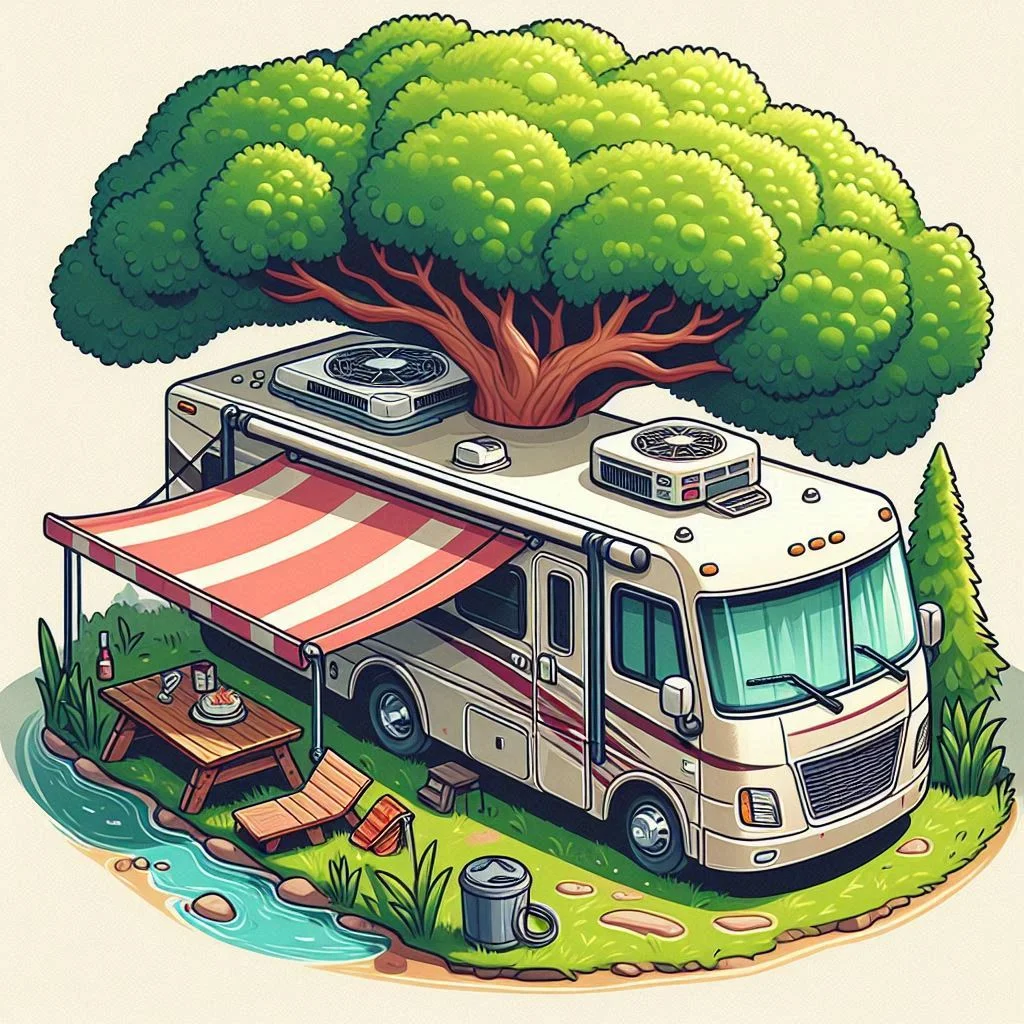
Additional Tips for Maintaining a Cool RV
- Close the Blinds: During the hottest parts of the day, keep the blinds or curtains closed to prevent the sun from heating up the interior of your RV.
- Insulate Your RV: Insulating your RV can help keep the temperature inside stable, reducing the strain on your air conditioner. Insulation helps keep the cold air in and the hot air out.
- Monitor Energy Consumption: If your RV is equipped with an energy monitor, use it to keep track of your power usage. This can help you identify when the AC is consuming more power than necessary.
FAQs About RV Air Conditioners
Below are some common questions RV owners have regarding air conditioners in their vehicles. We’ve provided detailed answers to help you understand your RV’s air conditioning system better and make the most of it during your travels.
1. How do I turn on my RV air conditioner?
Turning on your RV air conditioner is straightforward, but it requires ensuring that your RV is connected to a power source, and the unit is in proper working condition.
Step-by-step guide:
- Turn on the power: Ensure your RV is connected to a reliable power source, such as shore power, a generator, or solar power (if compatible).
- Locate the thermostat: The thermostat is usually located near the AC unit, either on the wall inside the RV or as a digital control on the unit.
- Set the desired temperature: Adjust the thermostat to the desired temperature, generally between 72°F (22°C) and 75°F (24°C).
- Switch to cooling mode: Make sure the thermostat is set to “cool” mode. If the AC is already in cooling mode, it will start cooling immediately.
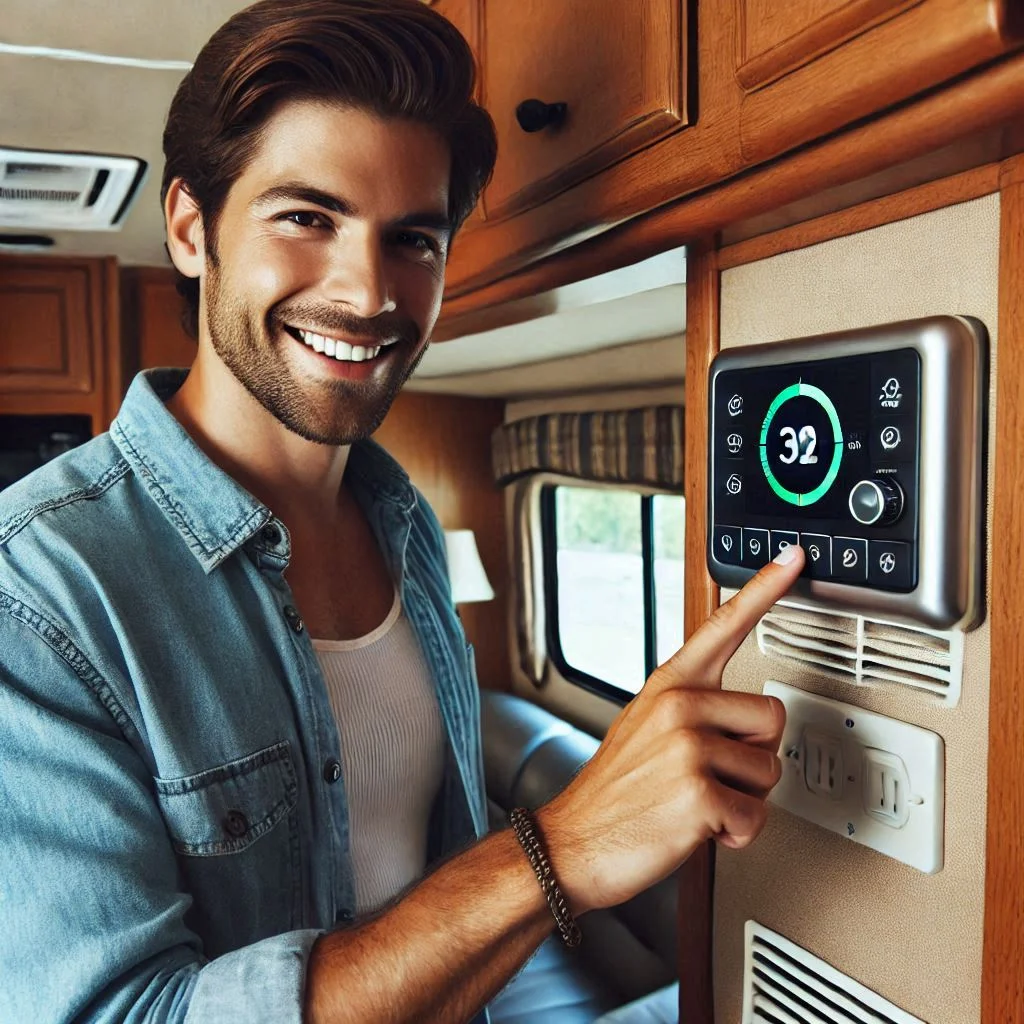
- This image can help guide users on how to operate the RV air conditioner.
2. How does an RV air conditioner work?
RV air conditioners work similarly to traditional home AC systems but are designed for the limited space inside an RV. The cooling process involves a cycle of evaporation and condensation.
Explanation:
The RV air conditioner uses a compressor to pump refrigerant through a system of coils. The refrigerant absorbs heat from the air inside the RV and moves the heat outside. The cool air is then blown back inside, ensuring your RV stays comfortable.
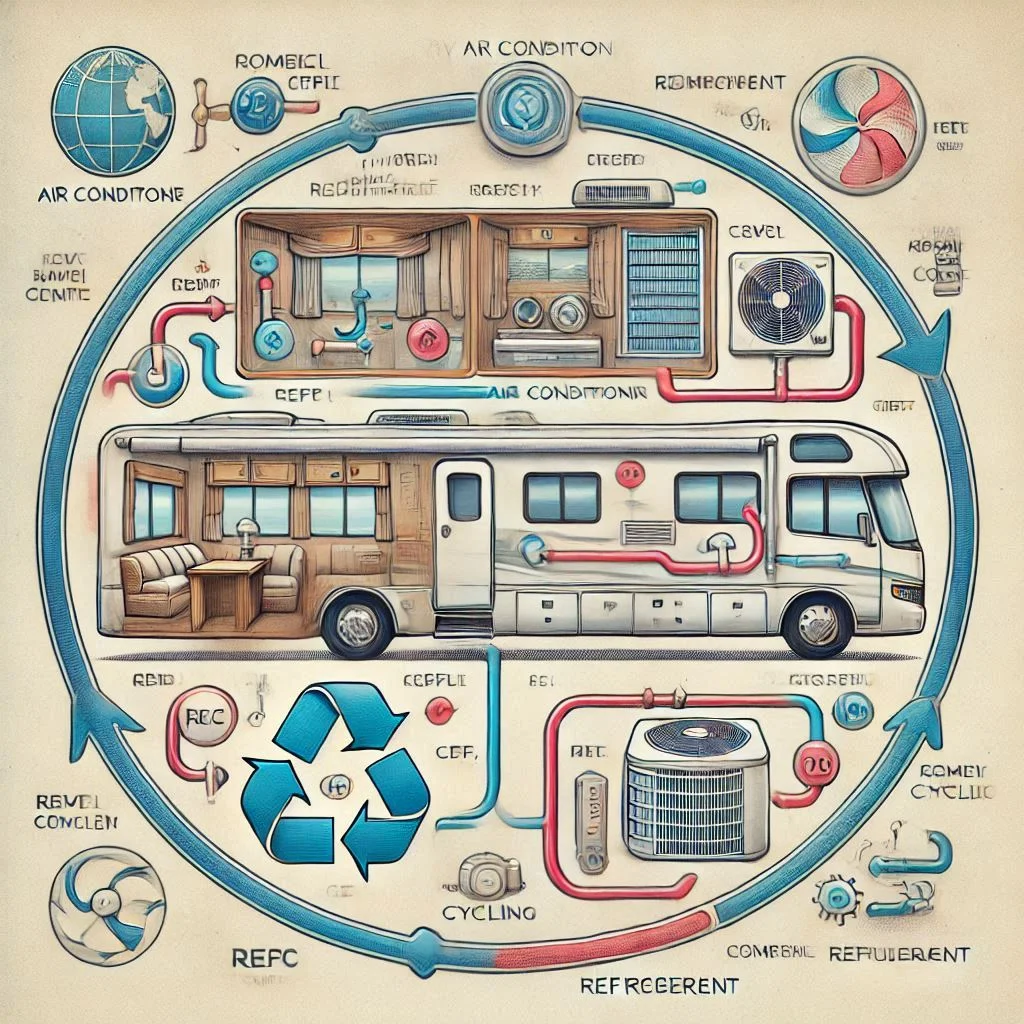
3. Can an RV air conditioner run continuously?
Yes, an RV air conditioner can run continuously, but there are important considerations regarding power usage and wear on the system.
Pros:
- Continuous running maintains a stable, comfortable temperature.
- Avoids the sudden temperature shifts that may occur when turning the AC on and off.
Cons:
- Constant use puts more strain on the system and could lead to wear over time.
- It can consume a significant amount of power, especially in remote areas where you may rely on solar panels or generators.
How long is it safe to leave your RV AC running?
If the air conditioner is well-maintained, it’s generally safe to run it continuously for several hours. However, it’s recommended to turn it off during extended periods of inactivity to conserve energy and prevent unnecessary wear.
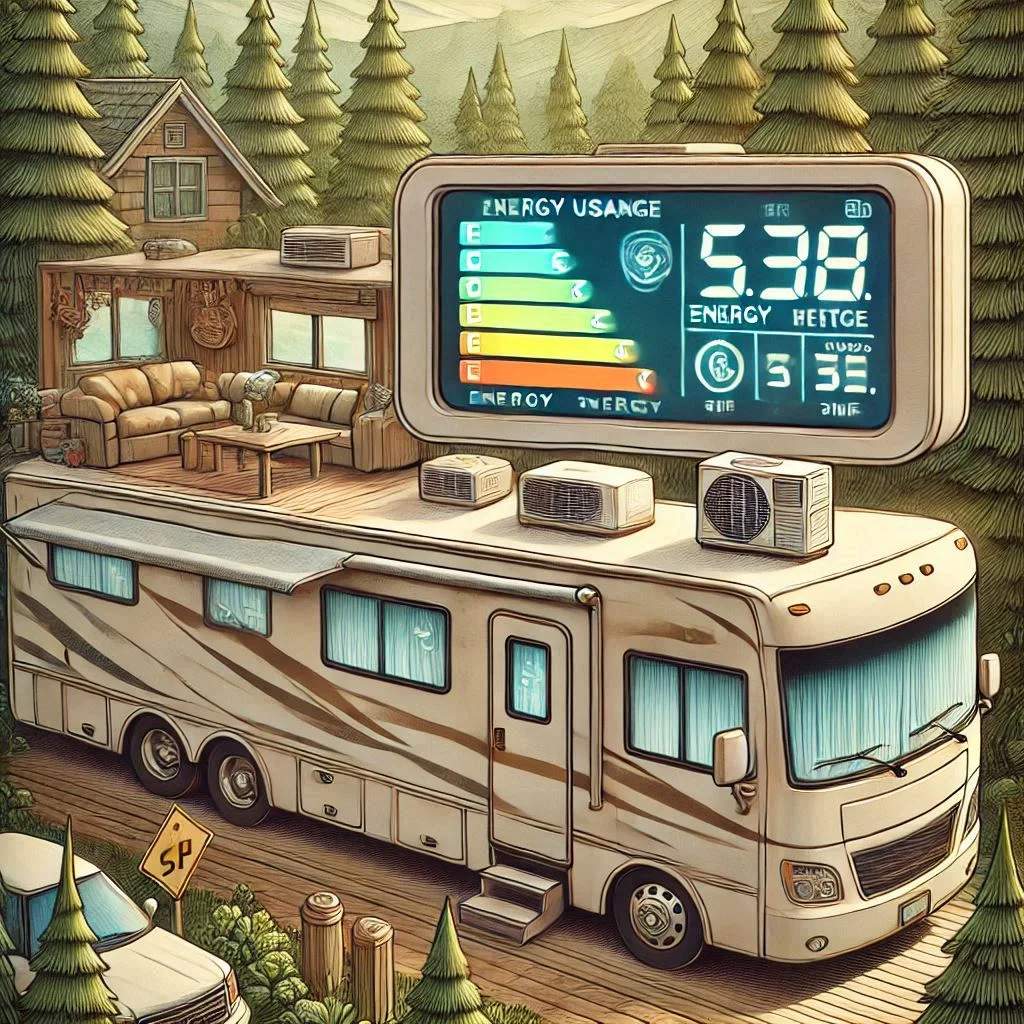
4. What is the best setting for an RV air conditioner?
The best setting for your RV air conditioner largely depends on your comfort preferences and the outside temperature. However, it’s recommended to set the thermostat to between 72°F (22°C) and 75°F (24°C) to balance comfort with energy efficiency.
Key factors:
- Energy Efficiency: Setting the temperature too low will cause the AC to run constantly, using more energy. A moderate setting ensures efficient cooling without unnecessary power use.
- Comfort: When traveling in very hot climates, setting the AC a bit lower can help maintain a comfortable interior. Conversely, on cooler days, you may raise the temperature slightly.
5. Do RV air conditioners run on propane?
No, RV air conditioners do not run on propane. RV air conditioners are powered by electricity, either from shore power, a generator, or solar panels. Propane is typically used to power appliances like stoves, water heaters, and refrigerators, but not the air conditioner.
6. How do you reset an RV air conditioner?
If your RV air conditioner is not working properly, you may need to reset it. Here’s how you can do that:
Steps to reset the RV air conditioner:
- Turn off the air conditioner using the thermostat or the power switch.
- Disconnect power: Unplug the RV from the power source or turn off the circuit breaker.
- Wait for 10 minutes: Allow the air conditioner to reset and cool down.
- Reconnect power and turn the air conditioner back on. This should resolve any minor issues like freezing up or power surges.
7. How long do RV air conditioners last?
The lifespan of an RV air conditioner varies depending on factors such as usage, maintenance, and brand. On average, an RV air conditioner can last between 5 and 10 years. Regular maintenance, such as cleaning the filters, inspecting the coils, and ensuring there are no leaks in the ductwork, can help extend its lifespan.
Conclusion
In conclusion, understanding how to properly use and maintain your RV air conditioner is crucial for ensuring a comfortable and energy-efficient travel experience. From turning on the AC to performing regular maintenance and adopting energy-saving practices, the steps outlined in this guide will help you get the most out of your RV air conditioner. By following best practices, troubleshooting common issues, and keeping your system well-maintained, you can enjoy a cool, comfortable environment inside your RV, no matter where your adventures take you. Stay cool, save energy, and extend the lifespan of your RV air conditioner by implementing these expert tips. Safe travels and happy RVing!


